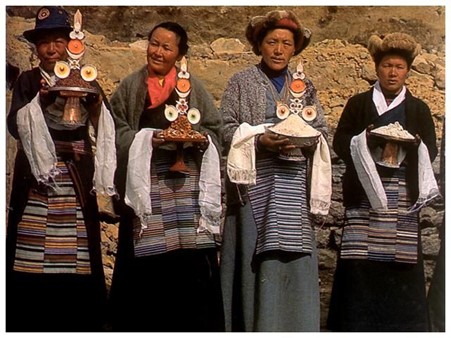
Sherpa women in traditional dress
In our homeland of the Solu-Khumbu, Everest, region we have many festivals, but three major ones, which I am pleased to say a few words on below. Sharing about these is important to us because celebrating the festivals here in Britain across our community (a small one of about 1000+ people) and in our family homes is a most effective way of retaining connection to the culture of the land of our part of the mighty Himalaya in this remote and very different land. By sharing we preserve our culture through the action of explaining about it to our British friends, and, we hope in so doing adding a little to the human and social wealth that we have in the United Kingdom through our multicultural nation.
About Losar: Losar is the festival of the Sherpa’s New Year. An auspicious occasion in which feasting accompanied by song, dance and drink are the rule. We celebrate the festival towards the end of the Western month of February. Losar aligns to the Tibetan calendar, and as such differs in point of timing to Nepali New Year (which takes place in the April period).
About Dumje: Our Dumje festival takes place over seven days, and is about celebrating good health, the prosperity, and for the welfare of the Sherpa community in general. Dumje takes place in the Western calendar month of July. This is because then agricultural work has been accomplished and we take at this time our herds to the upper pastures, and also coincides with our trading expeditions over to Tibet being completed. A particularly important dimension of Dumje is for Sherpas, who are very spiritual people, going to visit and offer prayers at the monasteries and offer prayers to their gods. Our young people involve on the festival’s singing and dancing: a happy time for all ages is Dumje which sees food and drink enjoyed greatly in good and happy spirit. We try where able as a community and on family level to celebrate all the elements of Dumje that are possible within our community in the UK.
About Mani Rimdu: Mani Rimdu celebrations are held four times a year, twice in Khumbu (at the Tami and Tengboche monasteries) and twice in Solu-Khumbu (at the Chiwong and Thaksindhu monasteries). Monks in colorful costumes and elaborate masks impersonate gods and demons and perform religious dances intended to scare the evil spirits.
On the concept of Mani Rimdu we are aware that our expression of a complex spiritual concept that Mani Rimdu manifests is not easily at first glance simple for Western people to grasp – it can look like a quaint folklore festival. It is not so regarded on our side, but relates to very tangible realities in the human experience. Here we can say that evil manifests in many different forms and the forces that spy it, go to battle with it, and may or may not defeat it in a person, a society and — as we have seen with for example the Nazis in the late 1920’s to 1945 in Germany a venerable European land from Roman times in your history – even nations, are very real to the human day to day life experience.
NOTE: On the Gyalpo Losar Festival 2047, please also see the rare and precious footage of ancient ceremonial rites and dedications, as well as a set of exceptional dance, music, and songs performed at the festival. Links to these are provided at the end of the cultural festivals, concluding part of this section of the UK Nepali cultural & social heritage resource.
Note on Sherpa Music:
We are very pleased to provide in this section of the information resource direct links to the Losar Sherpa New Year 2047, Ashford, Sherpa Association UK celebrations recording of a set of Sherpa dance performances (thanks to the Association) in which traditional and popular Sherpa and Nepali music is provided as the setting for the dances:
On the guidance of the Association we also provide some further information on Sherpa music:
In 1973, anthropologist John M. Bishop recorded music of the remote village of Melemichigaon, Nepal. With influence from Tibet, this Nepalese music is characterized by unison singing and occasional accompaniment on the damian, a stringed instrument in the lute family that provides a strong rhythmic base. The musicians generally sing in Helambu (a Sherpa-Tibetan dialect) and sometimes in Tibetan on themes of religion, a desire for material wealth, the natural landscape, and a “sense of an ordered world in contrast to the nomadic pattern of many peoples’ lives” (Bishop). Liner notes include a description of the village and its music, track notes, and lyrics in Helambu/Tibetan and English.
Source: https://folkways.si.edu/music-of-a-sherpa-village/world/album/smithsonian
